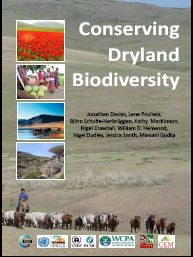CMS Contributes to Analysis of Biodiversity in the Drylands
 Bonn,
Bonn,
17 September 2012 - IUCN, UNEP-WCMC and UNCCD have
published Conserving Dryland Biodiversity, the first comprehensive
analysis of the plant and animal species as well as human
populations of the drylands of the world.
Crucially, it shows how to conserve biodiversity,
while protecting the land from degradation and improving
the livelihoods of the rural communities that live and directly
depend on it.
The invitation to participate provided
an opportunity for the CMS Secretariat to further enhance
its collaboration with partners. CMS contributed to the
publication in its capacity as the recognized lead expert
of CBD on migratory species to highlight the mutually beneficial
relationship between them and their arid habitats. Arid
lands provide an important refuge for many threatened migratory
species, which play an important role in keeping the soil
fertile. The publication features arid land mammals such
as the Bactrian camel and the Saiga antelope, which cover
large distances during their migrations and depend directly
on interconnected and intact steppe ecosystems for their
survival.
The value of the book cannot be overstated
given the potential ecosystem impacts that would arise from
a wanton loss of dryland biodiversity and the social, human
and economic costs that follow community-biodiversity conflicts.
Conserving Dryland Biodiversity presents
practical choices on how to accommodate both conservation
and development goals. It shows the huge potential in traditional
land-use and pastoral practices to balance these demands.
The significance of the drylands for the
global community is either highly undervalued or perceived
from a very particular viewpoint. The value of drylands
goes beyond sustainable use of the natural resources and
bio-prospecting. And the myth of drylands as the stocking
zones for meat and game production is deconstructed in the
book.
The book highlights how a majority of
the rural communities and small-scale producers that depend
directly on the land have a more holistic view because of
their multiple uses of the land; from water, to fuel wood,
medicines, pasture and food.
With its focus on bridging the divide
between meeting development and conservation needs through
the use of effective local practices, Conserving Dryland
Biodiversity is a useful tool for awareness raising among
wildlife enthusiasts and development workers alike.
The publication was launched on 9th September
at the World Conservation Congress taking place in Jeju,
South Korea.
Last updated on 16 June 2014


